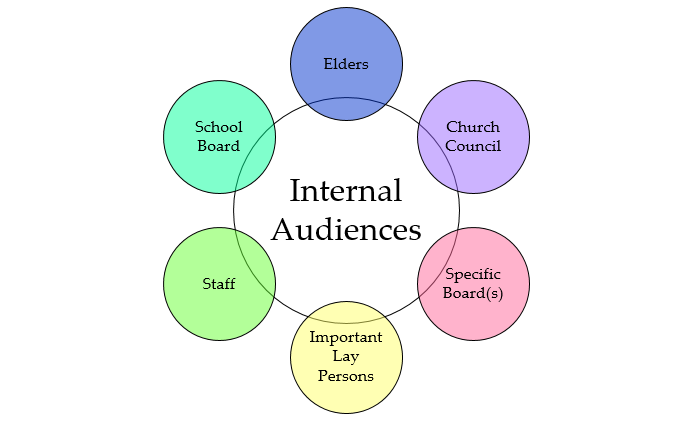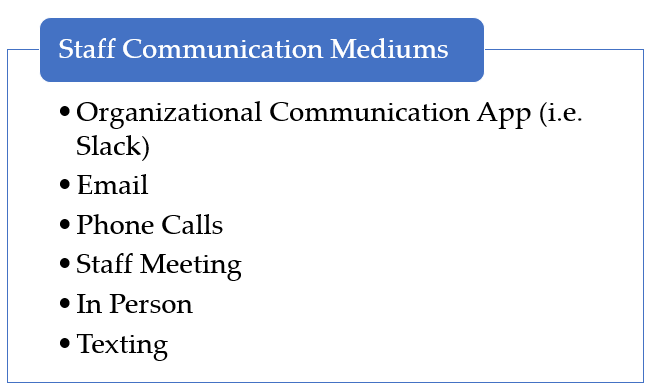
“Why haven’t they replied to the email? I sent it over a week ago.”
—A pastor who shall remain anonymous
That is a true complaint I have heard from another pastor. And I have heard similar remarks from other people. In fact, I am fairly certain I have made a parallel lament at some point myself. I am also willing to bet that the readers of this blog have made it too.
Usually on this blog, we look at external communication. But this time, we are looking at internal communication. An internal audience is those people within or closely related to a group or organization. For a church or church school, this may be staff and lay leaders (e.g., board or committee members, council members, elders, etc.).
Going back to the above grievance, in talking with the fellow pastor, it soon became apparent why the person had not replied in over a week. The person in question, while an important council member, was also recently retired. What had happened was shortly after retiring, he had stopped checking his email every day and would check it maybe once every couple of weeks. The only reason he would check it sooner was if somebody gave him a heads up that they had sent an email about something. After spending twenty-plus years in an office staring at a computer screen, he had no desire to do it in his retirement. Honestly, who could blame him?
Often, great detail is gone through in reaching out to targeted external audiences. The CTS blog has several posts that talk about reaching external audiences through different mediums. Rarely is the same care and effort expended on internal audience communications. This, in turn, leads to mounting frustrations and stress. However, this can be greatly mitigated by simply segmenting the internal audiences.
Define the Audience
To whom are you communicating? The first step in defining your audience is to identify your church’s internal audiences. You can get started by grouping the official and unofficial organizational structures:

While the chart above is merely an example, it helps to visualize what separate groups there might be for internal communications. Often there are overlaps between groups, as with any small organization such as a church. The point here is to figure out the specific people you want to communicate with or who you communicate with on a regular basis.
Figure Out Preferred Communication Methods
Email is great for passing on information. Texting is good for those with whom you communicate frequently when you cannot call them. Phone calls and face-to-face conversations are the best. Yet, each of these has its own unique advantages and disadvantages.
People are quickly souring on email communications. Now that their offices can follow them around 24/7/365, many working adults no longer receive a thrill at opening their inbox and hearing the old standby, “YOU’VE GOT MAIL!” Millennials’ interpersonal skills are often lower than older adults’. As such, communicating by phone is often awkward and painful for them and many actively avoid it, preferring to text or even email and letting phone calls go to voicemail. Retirees, no longer chained to a set schedule, can seem almost flighty on emails and texts, but many answer the phone or return missed calls almost immediately.
This is usually where the frustration in internal communication comes in. Everybody has a preference for communication, and this requires different communication mediums for even small groups.
Let’s run through a couple of examples from our chart above.

For staff members, all these might be valid ways of communication in a one-size-fits-all way. This is because staff are usually trained in the various ways an office might communicate and know which option to use in each circumstance. But, due to the very nature that most churches have small staffs that are in frequent contact with each other, communication at this level is usually pretty natural and much might get done through simple “water cooler” conversations. Rarely do you need to send a text letting other staffers know you sent an email.
Follow Up
But what about a different internal group? Let’s make a hypothetical church council that consists of one single millennial, two millennials with young children, two retirees (one of whom does not own a computer), a high-level business executive, a farmer with grown children, one stay-at-home parent with middle school age children, two working middle-age parents, two pastors, a director of Christian education, and you (a church staff member) for a total of fourteen council members. How do you communicate with them all? Obviously, you send an email. Saves you time, the information is consistent, etc. But how do you get them to all read and respond to the email in a timely manner? And what about the person who does not own a computer?
It might look something like this after sending the email:
- Send a “heads up” text to millennials, stay-at-home parent, working parents
- If stay-at-home parent does not respond to text in reasonable amount of time, call
- If working parents do not respond to text in reasonable amount of time, call
- Call retirees and farmer to let them know you sent an email
- Explain the information to non-computer retiree and tell them you will leave a letter in their mailbox
- Leave letter in their mailbox
- Explain the information to non-computer retiree and tell them you will leave a letter in their mailbox
- Send email to both work and personal for high-level business executive
- Wait thirty minutes to an hour, let pastors and DCE know about email by telling them in person as you get them coffee 😉
Often, the more diverse the demographics are in an internal audience, the more ways of communication you will need to employ. In other words, it means more work on your part than simply sending an email. In the above example, it is highly likely that more than half the recipients will have read and replied to your email before you need to contact them with a follow-up. However, if no follow-ups were done, at least one person would never get the email, and more than likely three to five would respond too late if it were a time-sensitive matter.
Whether you write this information out or just keep it in your head, utilizing the various ways to get your message out will greatly reduce your frustration.
Hear from Pastor Ross live as we chat with him about his own experiences with internal audience segmentation.
Thursday, July 19 at 11:30 a.m. (CDT) on Facebook
























